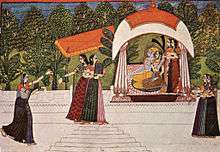Rajput painting


Rajput painting, also called Rajasthani painting, evolved and flourished in the royal courts of Rajputana in India. Each Rajput kingdom evolved a distinct style, but with certain common features. Rajput paintings depict a number of themes, events of epics like the Ramayana. Miniatures in manuscripts or single sheets to be kept in albums were the preferred medium of Rajput painting, but many paintings were done on the walls of palaces, inner chambers of the forts, havelis, particularly, the havelis of Shekhawati, the forts and palaces built by Shekhawat Rajputs.
The colours were extracted from certain minerals, plant sources, conch shells, and were even derived by processing precious stones. Gold and silver were used. The preparation of desired colours was a lengthy process, sometimes taking weeks. Brushes used were very fine.
Schools
In the last decades of the 16th Century Rajput art schools began to develop distinctive styles combining indigenous as well as foreign influences (Persian, Mughal, Chinese, European) into unique styles. Rajasthani painting consists of four principal schools that have within them several artistic styles and substyles that can be traced to the various princely states that patronised these artists. The four principal schools[1] are as follows:
- The Mewar school that contains the Chavand, Nathdwara, Devgarh, Udaipur and Sawar styles of painting
- The Marwar school comprising the Kishangarh, Bikaner, Jodhpur, Nagaur, Pali and Ghanerao styles
- The Hadoti school with the Kota, Bundi and Jhalawar styles and
- The Dhundar school of Amber, Jaipur, Shekhawati and Uniara styles of painting.
The Kangra and Kullu schools of art are also part of Rajput painting. Nainsukh is a famous artist of Pahari painting, working for Rajput princes who then ruled that far north.
Economic prosperity of commercial community and revival of “Vaisnavism” and the growth of Bhakti Cult were the major factors that contributed greatly to the development of Rajasthani paintings. In the beginning this style was greatly influenced by religious followers like Ramanuja, Meerabai, Tulsidas, Sri Chaitanya, Kabir and Ramanand.
All of Rajputana was affected by the attack of the Mughals but Mewar did not come under their control till the last. This was the reason that Rajasthani school flourished first in Mewar, (the purest form and later on in), Jaipur, Jodhpur, Bundi, Kota- Kalam, Kishangarh, Bikaner and other places of Rajasthan.
See also
- Mewar painting
- Kangra painting
- Tanjore painting
- Dalchand, an 18th-century Rajput artist
References
- ↑ Neeraj, Jai Singh (1991). Splendour Of Rajasthani Painting. New Delhi: Abhinav Publications. p. 13.
- The City Palace Museum, Udaipur: paintings of Mewar court life. by Andrew Topsfield, Pankaj Shah, Government Museum, Udaipur. Mapin, 1990. ISBN
094414229X.
- Splendour of Rajasthani painting, by Jai Singh Neeraj. Abhinav Publications, 1991. ISBN 81-7017-267-5.
- Art and artists of Rajasthan: a study on the art & artists of Mewar with reference to western Indian school of painting, by Radhakrishna Vashistha. Abhinav Publications, 1995. ISBN 81-7017-284-5.
- A study of Bundi school of painting, by Jiwan Sodhi. Abhinav Publications, 1999. ISBN 81-7017-347-7
- Court painting at Udaipur: art under the patronage of the Maharanas of Mewar, by Andrew Topsfield, Museum Rietberg. Artibus Asiae Publishers, 2001. ISBN 3-907077-03-2.
- Rajput Painting, by Ananda K. Coomaraswamy, Publisher B. R. Publishing Corporation, 2003. ISBN 81-7646-376-0.
- The artists of Nathadwara: the practice of painting in Rajasthan, by Tryna Lyons. Indiana University Press, 2004. ISBN 0-253-34417-4.
Further reading
- Dalrymple, William. (2016). The beautiful, magical world of Rajput art.] New York Review of Books, November 26, 2016.
- Kossak, Steven. (1997). Indian court painting, 16th-19th century. Metropolitan Museum of Art. ISBN 0870997831
External links
- Indian medieval painting schools - Rajput painting
- Indian Court Painting, 16th-19th Century from the Metropolitan Museum of Art
Category:Indian painting
| Wikimedia Commons has media related to Rajasthan style. |